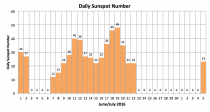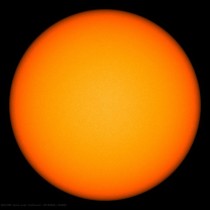Update
Eight more spotless days late in June brought the monthly total to 12. July started with 4 sunspotless days before for July 5th, it jumped to 23.
--------
So Constant And Unspotted Didst Thou Seem (Shakespeare 1)
Guest essay by David Archibald
The image of the Sun today is spotless.
This is the first spotless day of the 24-25 solar minimum. Not a great deal can be read from that. According to Wilson, for cycles 9-14, sunspot minimum followed the first spotless day by about 72 months, having a range of 62-82 months; for cycles 15-21, sunspot minimum followed the first spotless day by about 35 months, having a range of 27-40 months. So we could still be six years from minimum making Solar Cycle 24 about 13 years long. Longer is weaker in the following cycle, and colder.
When the Sun goes blank we still have what the professionals use - the F10.7 flux:

Figure 1: F10.7 Flux 2014 - 2016
Figure 1 shows that the F10.7 flux has been in a couple of parallel downtrends since early 2015. The Interplanetary Magnetic Field is still going the other way though:
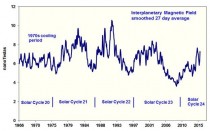
Figure 2: Interplanetary Magnetic Field 1966 - 2016
Cloud droplet nucleation initiated by galactic cosmic rays has been getting a favourable press again, so let’s see how that’s going:

Figure 3: Oulu Neutron Count 1964 - 2016
Figure 3 shows a strong rise in the neutron flux that has its source in the constant flux of galactic cosmic rays entering the solar system. The count is now higher than that during the downramp of Solar Cycle 20 of the 1970s cooling period - very promising.
Solar wind flow [pressure] is one of the factors that modulates that constant flux:
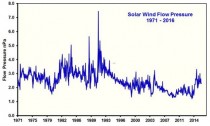
Figure 4: Solar Wind Flow Pressure 1971 - 2016
Solar wind flow pressure appears to have peaked for this solar cycle. Perhaps the most interesting story with respect to the Sun at the moment is the increasing hemispheric asymmetry. The following graph shows that using very fresh data up to 2nd June:
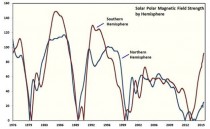
Figure 5: Solar Polar Magnetic Field Strength by Hemisphere 1976 - 2016
Asymmetry has reached a new peak for the modern instrument record and is still climbing:

Figure 6: Solar Polar Magnetic Field Strength Differential
Polar magnetic field strength is translated into sunspot number and sunspot area. Unfortunately NASA hasn’t updated hemispheric sunspot area since December 2015 with that data shown in this post. They may be too busy on Muslim outreach to do basic science.
1 Shakespeare in the movie adaptation of Henry V
David Archibald is the author of Twilight of Abundance (Regnery)





